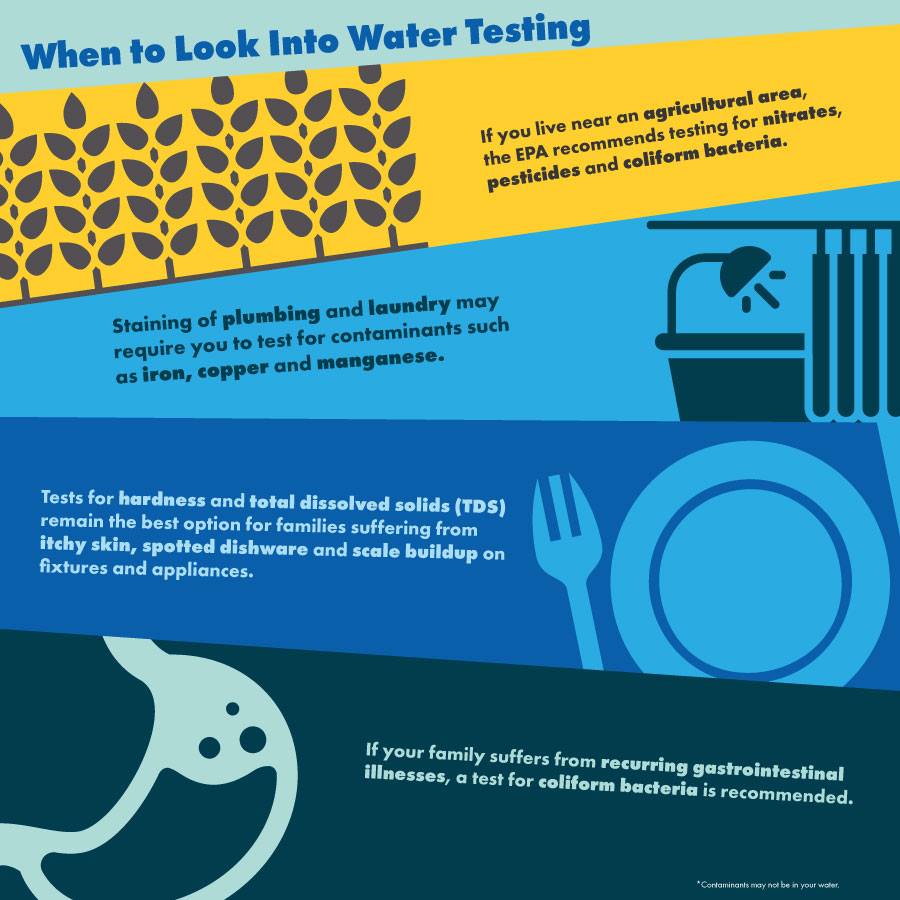Home Water Testing - Why is it Important for Your Family?
Maintaining your family's health and well-being starts with home water testing. Because water is a huge part of our daily lives.
Posted in
Contaminant,
Culligan Solutions,
Drinking Water,
Hard Water,
Healthy Home,
Water Problems,
Water Treatment

On average, each household in the United States uses roughly 300 gallons of water per day.
1 million miles of pipes, many of which were laid in the early to mid-20th century, deliver water to homes across the nation. And families depend on this water for many different things. Such as cleaning, cooking and drinking.
With consumption levels so high, it's necessary to make sure that your home's water is free of any contaminants. Including lead, iron, magnesium, arsenic, nitrates and bacteria to name a few.
What Do Water Tests Measure?
Water tests measure the presence of contaminants. And the Safe Drinking Water Act defines contaminant as any physical, chemical, biological or radiological substance in water.
Physical contaminants include any matter that impacts the physical appearance or properties of water. Such as sediment or organic material existing in lakes, rivers and streams.
The United States Environmental Protection Agency (EPA) classifies elements or compounds as chemical contaminants. They may be naturally occurring or man-made. And examples include nitrogen, pesticides, metals and pharmaceutical toxins.
Bacteria, viruses, protozoan and parasites are considered biological contaminants.
Lastly, the EPA defines radiological contaminants as chemical elements with an unbalanced number of protons and neutrons. As a result of this unbalance, atoms emit radiation. A few of these radiological contaminants include cesium, plutonium and uranium.
Contaminants and Their Impact on Health
In total, the EPA sets standards for more than 90 contaminants in drinking water. These 90 contaminants fall into one of two categories. And a contaminant's category depends on the type of health effects it may cause.
Acute effects occur within hours or days of consumption. Microbes, such as bacteria and viruses, result in the greatest chance of experiencing these health effects.
Most people's bodies fight off microbial contaminants like they fight off germs. So these acute contaminants don't typically have permanent effects. However, when consumed at high enough levels, they can be dangerous. Especially for people with compromised immune systems.
Chronic effects occur after people consume contaminants at levels over the EPA safety standards for extended periods of time. These contaminants include chemicals, radium and arsenic. Resulting health risks consist of cancer, liver issues, kidney problems or reproductive difficulties.
Common Drinking Water Contaminants
Arsenic
Naturally occurring in rock and sometimes found as an industrial byproduct, arsenic has been found in the groundwater of every state in the U.S. Exposure to this harmful contaminant may cause cancer, skin changes, gastrointestinal symptoms or disturbances of cardiovascular and nervous system functions.
Fluoride
Every person reacts to minerals differently. Fluoride is no different. As with all minerals, overexposure remains a danger. Teeth can become permanently damaged with discoloration. Or Neurotoxicity could occur and alter the normal activity of the nervous system.
Bacteria
Bacteria such as E. coli and Crypto present a greater risk in private wells compared to public drinking water systems. These pathogens enter water through the feces of infected humans or animals. Consequently, severe intestinal illnesses occur.
Lead
Lead typically enters a water supply through the plumbing. It is a primary concern for homeowners. Because it can be especially harmful for pregnant women, infants and young children. Detrimental effects range from stomach pain to brain damage.
Calcium and Magnesium
Minerals like calcium, sodium and magnesium do not necessarily have a direct impact on your health. But their presence causes hard water. Hard water results in dry, itchy skin. Another sign includes reduced lifespan of clothing and household appliances.
Nitrates
Phosphates and nitrates can leach into the groundwater. And those chemicals cause a number of health issues, such as kidney problems and cancer. These risks are especially high for pregnant and nursing women, infants and the elderly.
When Should You Look Into Water Testing for Your Home?
It can be difficult to know when to get your home's water tested. And the necessary water test can be impacted by several factors. Such as local and federal regulations, location, climate, infrastructure, agriculture and the desired detection level.
Fortunately, common signs exist to help you know when to conduct a water test.
For starters, if your family suffers from recurring gastrointestinal illnesses, a test for coliform bacteria is recommended.
An analysis for pH, lead or copper may indicate whether or not your household plumbing contains lead.
If you live near an agricultural area, the EPA recommends testing for nitrates, pesticides and coliform bacteria.
Tests for hardness and total dissolved solids (TDS) remain the best option for families suffering from itchy skin, spotted dishware and scale buildup on fixtures and appliances.
Staining of plumbing and laundry may require you to test for contaminants such as iron, copper and manganese.
If you detect a salty taste in your drinking water or live in an area with heavily salted roadways, experts suggest choosing tests that measure chloride, TDS and sodium.
And lastly, living in close proximity to gas stations or buried fuel tanks may require you to test for volatile organic compounds (VOCs).

Different Types of Water Tests
DIY Water Tests
If you suspect any of the previously mentioned water problems, it's possible to run a few tests of your own.
Many home water testing kits exist in the market. And these do-it-yourself versions are typically very affordable.
However, testing kits only tell you limited information about your water. Because most rely on treated slips to detect contaminants. And these slips are not always the most precise.
Home kits may alert you to exceptionally high levels of some common contaminants. But only a fully equipped lab staffed by professionals can provide you with accurate information.
Professional Water Tests
If you want a more detailed look at contaminants present in your water, consider a professional water test. Certified water testing labs give you access to more thorough test results.
And aside from detecting possible contaminants, water treatment professionals can provide you with expert advice. Offering you customized solutions that fit your lifestyle and budget.
Why Choose Culligan for Your Home Water Testing?
When it comes to water testing, your family has many choices. So why exactly should you call Culligan first?
For starters, we offer a wide range of testing options at various price points. Because we recognize that different households have different needs. So we make the testing process as easy and customizable as possible.
Free Water Analysis
Culligan offers basic water testing that's completely free. In fact, it's as simple as scheduling a time for your local Culligan expert to visit your home.
He or she will collect a sample from your tap and test it right in your kitchen. In 10 minutes or less.
After receiving the test results, they'll discuss whether it makes sense to conduct additional tests or consider a water treatment solution.
Our basic, free water test makes it easy to identify some of the more common problems experienced by homeowners. Such as pH levels, chlorine, magnesium, calcium and TDS.
Laboratory Water Analysis
Lab analyses reveal harder-to-identify water problems. Making them a great alternative to our free water test.
We understand the importance of water quality. So our EPA-certified laboratory results are returned in about three days.
Your Culligan specialist will then discuss the comprehensive findings. And recommend a host of personalized solutions.
It's important to note that we do charge for this type of comprehensive testing. But prices may vary. Speaking with your local Culligan expert will give you the best idea of available tests and their costs.
What Does it Mean to be EPA-Certified as a Lab?
For a laboratory to be EPA-certified, they must use approved methods to analyze drinking water compliance samples.
The EPA, governmental organizations, consensus method organizations, universities, water laboratories and commercial vendors all work together to develop such methods.
So what exactly is an approved analytical method?
First, a sample must be collected, preserved and stored in a way that will not impact test results. Contaminants in the sample are then gathered, separated, identified and measured.
For a test to be accepted, the EPA requires it to meet specific quality control criteria.
And lastly, the testing laboratory must report conclusions from the analysis.
In addition to this analytical process, labs must also pass periodic on-site audits to retain certification.
What Happens After Your In-Home Test?
Once home water testing is complete, the rest is up to you.
If you decide to move forward with a water treatment plan, contact your local Culligan expert.
Our residential treatment solutions include water softeners, whole home filtration systems, reverse osmosis and additional filtration options. So you are guaranteed to find one that works for your family and household.
